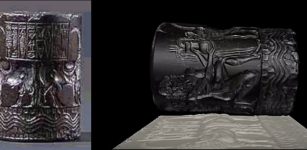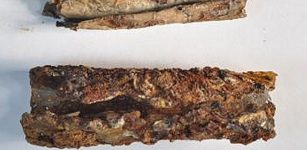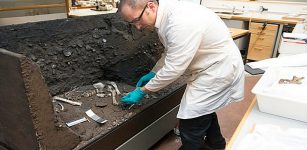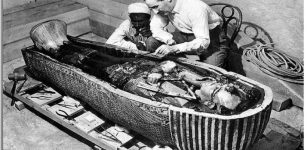Unique Well-Preserved 16th-17th Century Fabrics And Shoes Found In Toruń, Poland
Jan Bartek - AncientPages.com - Archaeologists have made a remarkable discovery during their research at the Camerimage film center construction site in Toruń, Poland. The excavation team has unearthed a unique collection of fabrics and shoes dating back to the 16th and 17th centuries.
Among the finds are well-preserved silk fabrics, fragments of intricately pleated dresses, and a cloth of gold adorned with a floral ornament. This discovery provides valuable insights into the textile craftsmanship and fashion trends of that era, offering a glimpse into the material culture of the past.
Archaeologists Professor Małgorzata Grupa (L) and Mariusz Ciszak (R) during the presentation of the largest collection of medieval fabrics in Europe, April 30th in Toruń. The discovery was made during archaeological work in Chełmińskie Przedmieście before the construction of the Camerimage European Film Centre. PAP/Tytus Żmijewski
Researchers at Chełmińskie Przedmieście have uncovered a remarkable collection of footwear and textile artifacts from the medieval period. The find includes complete shoes in Eastern and Western styles, spur straps, shoes with side cutouts, and trimmings from clothing necklines.
According to textile expert, archaeologist, and monument conservator Professor Małgorzata Grupa, there is no other similarly large collection of preserved fabrics and footwear from this European era. The artifacts are in remarkably good condition, and the scale of the find highlights the significance of Toruń as a major Hanseatic center where influences from the East and West converged.
The statement by archaeologist Mariusz Ciszak, whose team conducted research in the area, sheds light on the significance of the discovered monuments. According to Ciszak, these findings provide evidence and demonstrate that Toruń was one of the most prominent cities within the Hanseatic League, a powerful economic and defensive confederation of merchant guilds and towns in medieval Northern Europe.
Toruń played a key role in facilitating extensive trade connections across Europe during its heyday. According to Ciszak, who spoke to PAP, various artifacts discovered in the city, including antler products, metal goods, ceramics, fabrics, and leather items, attest to the exceptional craftsmanship of Toruń's artisans and their far-reaching commercial ties. The city served as a crucial link between the East and West, functioning as the economic and political hub of the Polish-Lithuanian Commonwealth during that era.
Credit: PAP/Tytus Żmijewski
According to Professor Malgorzata Grupa, research on the discovered objects and their conservation is still in its initial stages. She stated that these artifacts are found in various European locations, such as Amsterdam, London, Gdansk, Elblag, Wroclaw, Lübeck, Riga, and others. However, she highlighted that Torun has the largest accumulation of certain categories of these objects.
Furthermore, Professor Grupa mentioned that woolen stockings found in Europe are typically discovered as single items. Interestingly, during the research conducted for the ECFC film studio, 11 woolen stockings were found, with 3/4 being well-preserved. This finding is noteworthy as it represents a significant concentration of these artifacts in one location.
"In the cities we discover primarily the late Middle Ages. And here in the suburbs we have an amazing record of 16th and 17th centuries and this is information that is rare when we study cities. Such materials usually come from moats, and in this case it is a layer of mulch, so we can perfectly describe it all, date it, and outline the area of the preserved site.
Unfortunately, after a very thorough analysis, it turned out that the current research covered the edge of a 17th century property, and the entire object was moved towards the current CSW and the former Institute of History, and now the Marshal's Office," said Professor Grupa.
Researchers made an intriguing discovery in Chełmińskie Przedmieście during an excavation for a film studio. They unearthed modern footwear designed to be worn with both Western and Polish traditional attire.
'We have a meeting of the West and the East here in clothing, as well as in everything that was made at that time. Fabrics and leather are great proof of this. The quality of workmanship proves that it was not worn by people working in the suburbs, but made for people from higher social classes. This is evidenced by the straps on the high regalia shoes, which were used to attach spurs. Such shoes belonged to officers,' she said.
The recent archaeological finds in Torun provide valuable insights into the city's past. They confirm the existence of an interconnected system involving people, their livelihoods, and urban defense mechanisms. Evidence suggests the presence of a shoemaker's workshop and possibly a repair workshop in the area.
Notably, silk fabrics have been discovered in Toruń , a rarity previously found only in small fragments within the crypts of the churches of the Assumption of the Blessed Virgin Mary, Saint John's, and St. James. However, the excavation site at Jordanki, where the ECFC building is being constructed, yielded large pieces of clothing, including cloth gold, which was among the most expensive fabrics imported to Poland from Turkey or Persia during that era.
The discovered shoes were made for the poor and the wealthy, and all exhibited signs of wear, much like the fabrics. According to Professor Grupa, a comprehensive analysis of these elements will enable a more comprehensive understanding of how the inhabitants of Toruń dressed in the 16th and 17th centuries.
The archaeologist from the Nicolaus Copernicus University found the 'lovely woolen glove' particularly intriguing. Before this discovery, the professor had only encountered gloves from the graves of bishops who wore liturgical gloves during religious ceremonies. This woolen glove, however, represented a different type of artifact.
Credit: PAP/Tytus Żmijewski
"The glove found here was perfectly made of woolen yarn, but it was lined with silk. We can only wonder whether the glove belonged to an officer or one of the patricians. It certainly did not belong to a poor person," said Professor Grupa.
The archaeological finds from this site provide valuable insights into the textile industry and fashion trends of the Renaissance era. Among the notable discoveries are a cloth of gold adorned with floral patterns, crafted from silk thread interwoven with a gilded silver ribbon braid. Additionally, a fragment of a woollen bag was uncovered, potentially used for transporting dried fish or snuff. Traces of single-sided felting on the fabrics suggest their extensive use.
The collection also includes fragments of pleated dresses, felt pieces that may have been used to construct artificial hair attachments popular during the Renaissance, as well as technical and utility felt items. Various fabric scraps and a diverse array of shoes with multi-layered cowhide heels were also found. The presence of heels, both low and high, initially designed for men's Western-style clothing and later adopted by women, reflects the fashion trends of the time, where people sought to appear taller and slimmer.
See also: More Archaeology News
This comprehensive collection of textiles and footwear from a single site is considered one of the most impressive in Europe. It offers a remarkable glimpse into the material culture and sartorial practices of the Renaissance period.
Written by Jan Bartek - AncientPages.com Staff Writer























